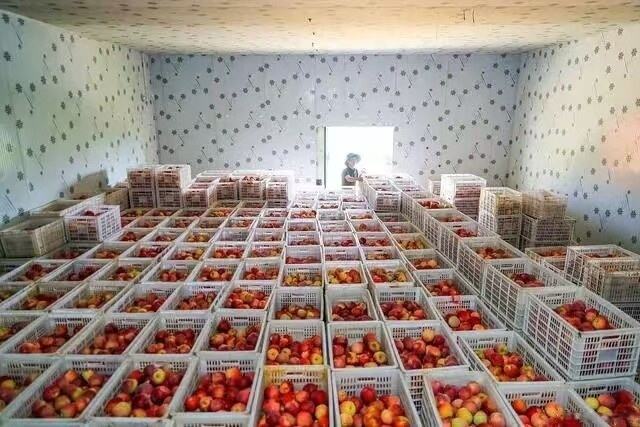Temperatursteuerung für optimale Kühlraumleistung
Ideale Temperatur- und Luftfeuchtigkeitsbedingungen für Kühlraum für Obst und Gemüse Aufbewahrung
Die Aufrechterhaltung von Temperaturen zwischen 0°C–13°C und einer relativen Luftfeuchtigkeit von 85–95 % verlangsamt enzymatische Aktivitäten und das mikrobielle Wachstum und erhält so die Zellintegrität von frischem Obst und Gemüse. Blattgemüse benötigt eine höhere Luftfeuchtigkeit (95 %) im Vergleich zu Wurzelgemüse (90–95 %), wodurch die Haltbarkeit gegenüber Lagerung bei Raumtemperatur um 30–400 % verlängert wird (Inbound Logistics 2024).
Kühlraumtemperaturbereiche nach Produktart
| Produktkategorie | Temperaturbereich | Luftfeuchtigkeitsniveau | Maximale Lagerdauer |
|---|---|---|---|
| Blattgemüse (Salat) | 32°F-36°F | 95-100% | 14-21 Tage |
| Wurzelgemüse (Karotten) | 33°F-39°F | 98-100% | 4–6 Monaten |
| Obst (Äpfel) | 30°F-32°F | 90-95% | 3-8 Monate |
| Beeren (Erdbeeren) | 32°F–34°F | 90-95% | 5 bis 10 Tage |
Einfluss von Temperaturschwankungen auf postharvest Verluste
Bereits Abweichungen um 2°F können die Verderblichkeit bei ethylenempfindlichen Kulturen wie Gurken um 18–25 % beschleunigen, da wiederholte Kühlzyklen die Zellmembranen schädigen. Dual-Sensor-Überwachungssysteme helfen dabei, eine Genauigkeit von ±0,5°F zu gewährleisten, wodurch Schwankungen minimiert und die Qualität erhalten bleibt (CoreX Partners 2024).
Vorkühlverfahren zur Stabilisierung der Temperatur vor der Lagerung
Hydrokühlung entfernt 24–30 BTU/lb Feldwärme innerhalb von 10–60 Minuten, während Zwangsluftkühlung eine Wärmereduktion um 75 % um 25–40 % schneller erreicht als Raumkühlung. Diese schnelle Vorkühlung verhindert Kondensation und Eiskristallbildung während der Kaltlagerung und erhält so Textur und Frische.
Luftfeuchtigkeits- und Luftstrommanagement zur Erhaltung der Frische
Anforderungen an die relative Luftfeuchtigkeit für verschiedene Produktkategorien
Die richtige Luftfeuchtigkeit verhindert, dass Lebensmittel austrocknen, und hält unerwünschte Mikroben in Schach. Blattgemüse wie Spinat gedeiht bei einer relativen Luftfeuchtigkeit von etwa 95 %, da es diese Feuchtigkeit benötigt, um fest und knackig zu bleiben. Wurzelgemüse wie Karotten und Kartoffeln fühlen sich bei 90 bis 95 % rel. Luftfeuchte wohl, wodurch sie ihre faltige, welke Optik vermeiden. Beerenfrüchte sind jedoch anspruchsvoller und kommen am besten mit einem Bereich von 85 bis 90 % rel. Luftfeuchte zurecht. Dieser Bereich ist hoch genug, um übermäßiges Austrocknen zu verhindern, aber nicht so hoch, dass Schimmelbildung einsetzt. Eine 2023 in der Fachzeitschrift Postharvest Biology and Technology veröffentlichte Studie bestätigt diese Erkenntnisse zu optimalen Lagerbedingungen für verschiedene Arten von frischem Gemüse und Obst.
Feuchtigkeitsregulierung und Luftzirkulation in Kühlräumen im Gleichgewicht halten
Intelligente Klimasysteme nutzen Echtzeitsensoren, um die Luftfeuchtigkeit mit der Luftströmungsgeschwindigkeit (0,1–0,3 m/s) auszugleichen. Zwiebeln beispielsweise benötigen eine niedrigere Luftfeuchtigkeit (65–70 %), um Fäulnis zu verhindern, während Äpfel wöchentlich 5–7 % ihres Gewichts verlieren, wenn die Luftfeuchtigkeit zu stark abfällt. Automatisierte Hochdruckvernebelung fügt gleichmäßig Feuchtigkeit hinzu, ohne Oberflächen zu benetzen, und bewahrt so Gewicht und Qualität.
Luftzirkulation und Stapelrichtlinien für eine gleichmäßige Kühlung
- Palettenausrichtung : Lassen Sie 10–15 cm Abstand zwischen Wänden und gestapelten Paletten
- Vertikale Luftströmung : Positionieren Sie belüftete Böden unter Behältern, um eine Aufwärtsbewegung der Luft zu ermöglichen
- Traglastbegrenzungen : Vermeiden Sie das Stapeln über 75 % der Raumhöhe hinaus, um tote Zonen zu eliminieren
Diese Maßnahmen gewährleisten eine gleichmäßige Temperaturverteilung und reduzieren Hotspots, die die Verderblichkeit beschleunigen.
Verpackungslösungen zur Verbesserung der Feuchtigkeits- und Luftstromregelung

Perforierte Polyethylenfolien halten die 95%ige RH für Brokkoli bei, während der Gaswechsel ermöglicht wird. Verpackungen mit modifizierter Atmosphäre mit Mikrophorationen verlängern die Haltbarkeit von Erdbeeren um 40% im Vergleich zu versiegelten Behältern. Atmungsaktive Kunststoffkisten reduzieren das Kondensationsrisiko um 33% gegenüber alternativen Massivwänden (Cold Chain Logistics Report, 2022).
Ethylengasmanagement und Produktkompatibilität
Wie Ethylengas die Reifung und Verwesung in gelagerten Erzeugnissen beeinflusst
Ethylen ist im Grunde die Art, wie die Natur sagt: "Zeit zum Reifen!" Selbst winzige Mengen, etwa 1 Teil pro Million, können diese klimakteriellen Früchte in Gang bringen - denken Sie an Äpfel und Tomaten, die ihren Reifungsprozess beginnen. Aber hier ist der Haken: Dieses gleiche Gas beschleunigt das Verrottungsprozess für Gemüse, das nicht so hart ist. Salat verwelkt schneller, Karotten werden bitter, wenn sie Ethylen ausgesetzt sind, weil es Chlorophyll abbaut. Laut einer Forschung von Post-Harvest Biology and Technology im letzten Jahr führt das falsche Verwerten von diesen Dingen zu einem Verlust von 12 bis 25 Prozent nach der Ernte, wenn verschiedene Lebensmittel zusammen gelagert werden. Das ist eine Menge verschwendeter Produkte, nur weil wir diese Gase nicht richtig in Lagereinrichtungen verwalten.
| Produkttyp | Ethylenreaktion | Beispielpflanzen |
|---|---|---|
| Klimakteriell | Reifung nach der Ernte mit Ethylenbelastung | Bananen, Avocados und Pfirsiche |
| Nicht klimakteriell | Ethylen verursacht Erweichung/Verfärbung | Brokkoli, Gurken, Zitrusfrüchte |
Trennung von Ethylen produzierenden und Ethylenempfindlichen Früchten und Gemüse
Produkte mit hohen Emissionen wie Äpfel und Cantaloups müssen von ethylenempfindlichen Kulturen wie Rosenkohl und Blattgemüse getrennt werden. Eine Studie zum Controlled-Atmosphere-Lager im Jahr 2024 ergab, dass ungegliederte Kühlräume die Verderbsrate um 18 % erhöhen im Vergleich zu unterteilten Einheiten.
Klimakterische vs. nicht-klimakterische Produkte: Reifeverhalten in der Kälte Lagerung
Klimakterische Früchte weisen während der Reifung einen Anstieg der Atmungsaktivität auf, was eine engere Temperaturkontrolle (innerhalb von 2–3 °F) erfordert, um die Ethylenbildung zu unterdrücken. Nicht-klimakterische Sorten reifen nach der Ernte nicht weiter und verschlechtern sich kontinuierlich; Kühlung verlangsamt diesen Prozess, kann aber Schäden durch Ethylenexposition nicht rückgängig machen.
Natürliche Reifung vs. Haltbarkeitsverlängerung: Ausbalancieren der Marktanforderungen
Ethylenabscheider und Kaliumpermanganat-Filter halten den Gehalt bei Langzeitlagerung unter 0,01 ppm. Umgekehrt führen einige Lieferketten in Endanlagen 10–100 ppm Ethylen ein, um die Reifung vor der Präsentation im Einzelhandel zu synchronisieren. Laserbasierte Gassensoren ermöglichen eine präzise Überwachung beider Ansätze.
Bewährte Methoden zur Verlängerung der Haltbarkeit in der Kälte lagern
Integrierte Kühlstrategien zur Maximierung der Frische
Fortgeschrittene Systeme kombinieren mehrstufige Kühlung mit Echtzeit-Temperaturüberwachung, um eine Genauigkeit von ±0,5 °C zu gewährleisten und Abfälle um 30 % zu reduzieren (Postharvest Biology Institute, 2023). Hybride Anlagen, die Verdunstungskühlung zusammen mit Kompressoren nutzen, senken den Energieverbrauch um 18–22 %, während sie die Knackigkeit empfindlicher Produkte bewahren.
Methoden zur Nachbehandlung zur Verringerung von Verderb
Unmittelbare Hydrokühlung reduziert die Atmungsrate von Avocados und Steinobst um 40 % (UC Davis, 2023). Chlordioxid-Begasung senkt die mikrobielle Belastung um 99,7 % und verlängert die Haltbarkeit von Gurken und Paprika um 5–7 Tage.
Belüftete Verpackungen und Lagerinnovationen zur Verlängerung der Haltbarkeit
| Verpackungsart | Bestes für | Luftstromzunahme | Zunahme der Haltbarkeit |
|---|---|---|---|
| Mikroperforiertes PP | Tomaten, Pilze | 35% | 10-12 Tage |
| Ethylenabsorbierende Innenfutter | Äpfel, Brokkoli | 50% | 14-18 Tage |
| Recycelbare Zellstofftabletts | Erdbeeren, Pfirsiche | 25% | 6-8 Tage |
Überwachungs- und Wartungsroutinen für eine gleichbleibende Kühlsystemleistung
Eine halbmonatliche Sensor-Kalibrierung verhindert 92 % der Temperaturschwankungen (ASHRAE, 2022). Automatisierte Abtauvorgänge in Zeiten geringer Auslastung reduzieren Eisbildung um 60 % und helfen dabei, optimale Feuchtigkeitswerte von 95 % rel. Luftfeuchte für Kräuter wie Basilikum und Koriander aufrechtzuerhalten.
Lageranweisungen für gängige Obst- und Gemüsesorten
Kühlraumeinstellungen für Blattgemüse, Wurzelgemüse und Kartoffeln
Spinat und Grünkohl bei 0–2 °C mit 95 % Luftfeuchtigkeit lagern, um Welken zu vermeiden. Karotten zeigen beste Ergebnisse bei 3–6 °C mit 85–90 % Luftfeuchtigkeit, um die Feuchtigkeitsbindung und Schimmelpilzprävention auszugleichen. Kartoffeln benötigen dunkle Bedingungen bei 4–7 °C und 90–95 % Luftfeuchtigkeit, um das Keimen hinauszuzögern (University of Maine, 2023).
Lagerung klimakterischer Früchte: Bananen, Tomaten und Reifeprotokolle
Bananen sollten bei 53–57 °F mit einer Luftfeuchtigkeit von 85–90 % gelagert werden, um die Reifung zu verlangsamen. Tomaten behalten ihre Festigkeit am längsten bei 50–55 °F. Für eine kontrollierte Reifung erhöhen Sie vorübergehend die Temperatur auf 68 °F und den Ethylengehalt auf 100–150 ppm.
Besondere Hinweise für Kräuter und empfindliches Gemüse
Basilikum ist anfällig für Kälteschäden unterhalb von 50 °F; lagern Sie es bei 52–55 °F mit 95 % Luftfeuchtigkeit. Verwenden Sie perforierte Behälter für Beeren, um die Feuchtigkeit zu regulieren, und legen Sie die Pilzbehälter mit Papier aus, um Kondenswasser aufzunehmen, ohne die Hüte auszutrocknen.
Referenztabelle: Ideale Bedingungen für wichtige Obst- und Gemüsesorten
| Produktkategorie | Temperaturbereich | Luftfeuchtigkeitsniveau | Ethylenempfindlichkeit |
|---|---|---|---|
| Blattgemüse | 32–36 °F | 95–100% | Hoch |
| Äpfel/Birnen | 30–32 °F | 90–95% | - Einigermaßen |
| Zitrusfrüchte | 38–44 °F | 85–90% | Niedrig |
| Wurzelgemüse | 38–45 °F | 85–90% | - Einigermaßen |
| Tropische Früchte | 50–55 °F | 85–90% | Variable |
Diese Richtlinien entsprechen den Erkenntnissen der USDA-Forschung zur Lagerung von Lebensmitteln im gewerblichen Bereich, nach der eine sachgemäße Kombination von Temperatur und Luftfeuchtigkeit die Verluste nach der Ernte bei wichtigen Pflanzenarten um 18–35 % reduziert.
FAQ-Bereich
Welche optimale Temperatur ist zum Lagern von Blattgemüse geeignet?
Blattgemüse wie Kopfsalat sollte bei Temperaturen zwischen 32 °F und 36 °F gelagert werden.
Wie wirkt sich Ethylen-Gas auf gelagertes Obst und Gemüse aus?
Ethylen beschleunigt die Reifung bei klimakterischen Früchten, führt aber bei ethylenempfindlichem Gemüse zu Verderb.
Welche Vorabkühlverfahren eignen sich, um die Temperatur vor der Lagerung zu stabilisieren?
Die Wasserkühlung (Hydrocooling) und die Zwangsluftkühlung sind wirksame Vorabkühlverfahren, um die Temperatur zu stabilisieren.
Wie wird die Luftfeuchtigkeit in Kühlräumen geregelt?
Die Verwendung intelligenter Klimasysteme mit Echtzeitsensoren, um die Luftfeuchtigkeit durch Luftstrom zu regulieren, ist eine effektive Methode, um die Feuchtigkeitsniveaus zu steuern.
Inhaltsverzeichnis
- Temperatursteuerung für optimale Kühlraumleistung
- Luftfeuchtigkeits- und Luftstrommanagement zur Erhaltung der Frische
- Anforderungen an die relative Luftfeuchtigkeit für verschiedene Produktkategorien
- Feuchtigkeitsregulierung und Luftzirkulation in Kühlräumen im Gleichgewicht halten
- Luftzirkulation und Stapelrichtlinien für eine gleichmäßige Kühlung
- Verpackungslösungen zur Verbesserung der Feuchtigkeits- und Luftstromregelung
-
Ethylengasmanagement und Produktkompatibilität
- Wie Ethylengas die Reifung und Verwesung in gelagerten Erzeugnissen beeinflusst
- Trennung von Ethylen produzierenden und Ethylenempfindlichen Früchten und Gemüse
- Klimakterische vs. nicht-klimakterische Produkte: Reifeverhalten in der Kälte Lagerung
- Natürliche Reifung vs. Haltbarkeitsverlängerung: Ausbalancieren der Marktanforderungen
- Bewährte Methoden zur Verlängerung der Haltbarkeit in der Kälte lagern
- Lageranweisungen für gängige Obst- und Gemüsesorten
- FAQ-Bereich

